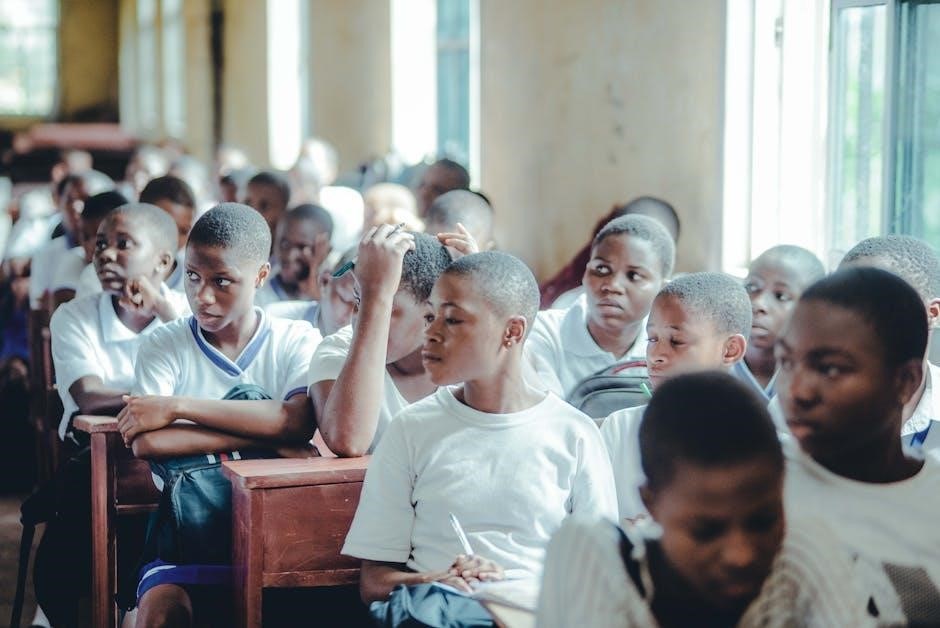Ghost Boys is a poignant novel by Jewell Parker Rhodes, exploring racial violence through the story of Jerome, a 12-year-old killed by a police officer, and his haunting aftermath․
1․1 Overview of the Novel
Ghost Boys by Jewell Parker Rhodes is a powerful middle-grade novel that tells the story of Jerome Rogers, a 12-year-old African American boy killed by a police officer in Chicago․ The narrative unfolds through Jerome’s ghostly perspective, offering a haunting exploration of racial violence and its impact on families and communities․ The novel connects Jerome’s story to historical cases, such as Emmett Till’s murder, to highlight the enduring legacy of racism․ With its poignant and timely themes, Ghost Boys serves as a chilling reminder of systemic biases and the need for societal change․
1․2 Importance of the Topic
The topic of Ghost Boys is crucial as it addresses systemic racism, police brutality, and the dehumanization of Black boys in America․ By shedding light on these issues, the novel sparks necessary conversations about justice, equality, and the value of Black lives․ It also highlights the emotional toll on families and communities, emphasizing the need for empathy and understanding․ Through its haunting narrative, Ghost Boys challenges readers to confront uncomfortable truths and advocate for change, making it a vital contribution to discussions about race and justice in contemporary society․

About the Author: Jewell Parker Rhodes
Jewell Parker Rhodes is an award-winning author known for her profound exploration of the Black experience, weaving historical and socio-political themes into gripping, poignant stories about race and justice․
2․1 Biography and Background
Jewell Parker Rhodes is an award-winning author and professor, known for her impactful storytelling centered on the Black experience․ With a strong academic background, she has crafted novels that address racial violence and its profound impact on families and communities․ Her work in Ghost Boys highlights her ability to weave historical and socio-political themes into gripping narratives․ Rhodes’ writing not only explores the complexities of race but also sparks essential conversations about justice and equality, making her a pivotal voice in contemporary literature․ Her contributions continue to resonate deeply in public discourse on race and social justice․

2․2 Her Work on Racial Issues
Jewell Parker Rhodes’ work confronts systemic racism and its impact on Black lives, particularly through her novel Ghost Boys․ She addresses police brutality, racial profiling, and the historical trauma faced by Black communities․ By weaving these themes into her storytelling, Rhodes humanizes victims of racial violence, challenging readers to confront uncomfortable truths․ Her writing sparks essential conversations about justice, equality, and the need for systemic change․ Rhodes’ ability to blend historical context with contemporary issues makes her a powerful voice in addressing racial injustices and advocating for a more equitable society․
Plot Summary of Ghost Boys
In Ghost Boys, Jerome Rogers, a young Black boy, is killed by a police officer․ His ghost witnesses the aftermath, exploring themes of race, justice, and legacy․
3․1 Main Character: Jerome Rogers

Jerome Rogers is a 12-year-old Black boy from Chicago, whose life is cut short in a tragic incident․ He is portrayed as a curious, kind-hearted boy who loves his family deeply, especially his mother․ Jerome’s character embodies the innocence and vulnerability of Black children in America, highlighting the harsh realities of racial injustice․ His journey as a ghost allows readers to see the world through his eyes, revealing his thoughts, fears, and hopes․ Jerome’s story is a powerful exploration of identity, resilience, and the enduring impact of systemic racism on young lives․
3․2 The Incident and Its Aftermath
The incident revolves around Jerome’s tragic death after being mistaken for a threat by a police officer․ His death sparks widespread outrage and grief, echoing real-life cases of racial injustice․ As a ghost, Jerome witnesses the aftermath, seeing his family’s pain and the community’s anger․ The event becomes a catalyst for activism, uniting people in demands for change․ Jerome’s spirit lingers, unable to move on, as he seeks justice and understanding․ The incident’s impact is profound, highlighting systemic issues and the long-lasting effects of racial violence on families and communities․
Themes in Ghost Boys
The novel explores systemic racism, fear, and trauma, while emphasizing hope and activism․ It highlights the interconnectedness of these themes in addressing racial injustice․
4․1 Racism and Police Brutality
In Ghost Boys, racism and police brutality are central themes, portrayed through Jerome’s tragic encounter with Officer Moore․ The novel vividly depicts how systemic racism leads to profiling and violence against Black individuals․ Jerome’s death mirrors real-life cases, evoking fear and trauma within his community․ Rhodes highlights the historical roots of such injustices, drawing parallels to Emmett Till’s lynching․ The story emphasizes the dehumanization of Black boys and the lasting impact on families and society․ By addressing these issues, the book challenges readers to confront uncomfortable truths about racial disparities and the need for systemic change․
4․2 Fear and Trauma
Ghost Boys explores the profound fear and trauma experienced by Jerome and his community․ Jerome’s death leaves his mother in a state of emotional withdrawal, unable to cope with the loss of her son․ The novel portrays the lingering fear of police violence among Black youth, as Jerome’s friend Carlos lives in constant dread․ Jerome’s presence as a ghost symbolizes the unresolved trauma, as he witnesses the pain he leaves behind․ The story underscores how systemic violence creates lasting emotional scars, affecting individuals and communities long after the incident occurs․
4․3 Hope and Activism
In Ghost Boys, hope emerges as a powerful counterpoint to the pervasive trauma and injustice․ Jerome’s journey as a ghost allows him to witness the resilience of his loved ones, particularly his mother, who begins to heal by advocating for justice․ The novel emphasizes the importance of community solidarity and activism in combating systemic racism․ Through Jerome’s story, Rhodes highlights the potential for collective action to inspire change and bring hope to marginalized communities․ The book encourages readers to engage in conversations about race and equality, fostering a sense of agency and optimism for a better future․

Key Characters in the Novel
The novel centers around Jerome Rogers, a young Black boy whose life is tragically cut short․ Other key characters include Officer Moore, whose actions spark the story, and Jerome’s family and friends, who grapple with grief and seek justice․
5․1 Jerome Rogers
Jerome Rogers is the protagonist of Ghost Boys, a 12-year-old Black boy from Chicago whose life is tragically cut short by a police officer․ His narrative unfolds as a ghost, trapped between worlds, seeking justice and understanding․ Jerome’s character embodies innocence, curiosity, and resilience, highlighting the human cost of systemic racism․ Through his eyes, readers witness the emotional and psychological impact of his death on his family and community․ His story serves as a powerful reminder of the lives lost to racial violence and the need for accountability and change․
5․2 Officer Moore
Officer Moore is the police officer responsible for Jerome’s death, a pivotal moment in the novel․ His character represents the complexities of systemic racism and personal accountability․ Moore’s actions are driven by fear and misunderstanding, leading to tragic consequences․ The novel explores his internal conflict and guilt, shedding light on the psychological toll of such events on all parties involved․ Through Moore’s character, Rhodes highlights the need for accountability and the broader societal issues that perpetuate racial violence, urging readers to reflect on justice, morality, and the consequences of fear-driven actions․
Historical Context
Ghost Boys draws parallels to historical cases of racial violence, such as Emmett Till’s lynching, to highlight systemic racism and its enduring impact on society․

6․1 Emmett Till and His Legacy
Emmett Till’s brutal murder in 1955 remains a pivotal moment in American history, symbolizing racial injustice․ His death, sparked by false accusations, led to widespread outrage and fueled the Civil Rights Movement․ In Ghost Boys, Jerome’s story mirrors Till’s, highlighting the ongoing struggle against systemic racism․ Till’s legacy endures through his mother’s courage in exposing his mutilated body, ensuring the world witnessed the atrocities of racial violence․ His story continues to inspire activism, reminding readers of the historical roots of modern-day struggles against police brutality and racial inequality, as depicted in the novel․
6․2 Other Historical Cases of Racial Violence
Beyond Emmett Till, numerous cases of racial violence have shaped America’s history․ The 1921 Tulsa Race Massacre, where a thriving Black community was destroyed, and the 1963 bombing of the 16th Street Baptist Church, killing four girls, highlight systemic racism․ Medgar Evers’ 1963 assassination and the 1955 murder of Lamar Smith further illustrate the violence faced by Black individuals․ These cases, like Jerome’s story in Ghost Boys, underscore the historical roots of racial injustice and the ongoing struggle for equality, echoing the novel’s themes of trauma and activism․
Social Impact of Ghost Boys
Ghost Boys sparks crucial conversations about race, injustice, and healing․ It fosters empathy, educates readers about systemic racism, and inspires activism, resonating deeply with communities seeking change․

7․1 Impact on Families and Communities
The novel profoundly illustrates the devastating effects of racial violence on families and communities․ Jerome’s death leaves his family shattered, grappling with grief and trauma․ The community unites in solidarity, seeking justice and healing․ Through their shared pain, they find strength and resilience․ The book highlights how such tragedies ripple through neighborhoods, fostering unity and inspiring collective action against systemic racism․ It underscores the emotional toll on loved ones and the broader societal need for change, offering a poignant reflection of the human cost of injustice․

7․2 Contribution to Public Discourse on Race
Ghost Boys plays a pivotal role in advancing public discourse on race by addressing systemic racism and police brutality through a deeply personal and emotional lens․ The novel sparks critical conversations about injustice, encouraging readers to reflect on historical and contemporary racial issues․ By centering Jerome’s story, Rhodes humanizes victims of racial violence, fostering empathy and understanding․ The book serves as a powerful tool for educating diverse audiences, particularly young readers, about the urgent need for racial equity and the importance of collective action to dismantle oppressive systems․

Literary Style and Structure
Ghost Boys features a lyrical, accessible prose style, blending Jerome’s ghostly perspective with vivid flashbacks․ The non-linear structure emphasizes the tragedy and emotional weight of his story․
8․1 Narrative Perspective
The novel Ghost Boys employs a unique narrative perspective, primarily told through Jerome’s voice, both in life and death․ This dual perspective allows readers to experience his final moments and the aftermath through his ghostly eyes․ The story also incorporates the viewpoints of other characters, such as his family and Officer Moore, creating a layered exploration of grief, guilt, and understanding․ Jerome’s voice is both haunting and hopeful, blending his vulnerability as a child with the wisdom of his untimely death․ This narrative choice amplifies the emotional weight of the story, making it deeply personal and universally relatable․ The alternating perspectives also highlight the broader societal issues at play, connecting Jerome’s fate to historical figures like Emmett Till․ By shifting between voices, Rhodes underscores the interconnectedness of past and present, emphasizing the enduring impact of racial injustice․ The narrative structure effectively balances individual tragedy with collective trauma, ensuring the story resonates long after the final page․ This approach not only honors Jerome’s memory but also challenges readers to confront the harsh realities of systemic racism․ The blending of perspectives creates a powerful call to action, urging readers to seek change and justice․ The narrative’s emotional depth and multifaceted viewpoints make Ghost Boys a compelling and thought-provoking read, ensuring its message lingers in the hearts of all who encounter it․
8․2 Use of Symbolism
In Ghost Boys, Jewell Parker Rhodes employs symbolism to deepen the story’s emotional and thematic resonance․ Jerome’s ghostly state symbolizes the lingering impact of racial violence and the lives lost to systemic injustice․ The bullet that kills him represents both the physical act of violence and the broader societal wounds it inflicts․ The ghost boys, including Emmett Till, symbolize the collective trauma of Black communities and the enduring legacy of racism․ The town itself serves as a symbol of limbo, where past and present collide, highlighting the ongoing struggle for justice and healing․ These symbols reinforce the novel’s powerful message․

Reception and Reviews
Ghost Boys has received widespread critical acclaim for its powerful portrayal of racial injustice and emotional depth․ Readers praise its thought-provoking narrative and relevance to ongoing conversations about race and police brutality․
9․1 Critical Acclaim
Ghost Boys has garnered significant critical acclaim for its unflinching portrayal of systemic racism and its emotional resonance․ Reviewers praise Jewell Parker Rhodes’ ability to address heavy topics with sensitivity, making the novel accessible to a wide audience․ The book has been hailed as a powerful addition to the conversation on race and justice, with many noting its importance in sparking dialogue․ It has also been recognized for its thought-provoking narrative structure, which blends the past and present to highlight historical injustices․ The novel has been named a New York Times bestseller and received multiple award nominations․
9․2 Audience Response
Ghost Boys has deeply resonated with readers, sparking emotional and thought-provoking discussions․ Many have praised its ability to address difficult topics like racism and police violence through a relatable and poignant narrative․ Readers, particularly young adults, have expressed how the novel has broadened their understanding of systemic injustice․ The book has also been credited with fostering empathy and encouraging conversations about race and equality․ Its accessible language and powerful storytelling have made it a favorite among book clubs and school reading lists, further amplifying its impact and relevance․
Ghost Boys is a powerful exploration of racism, injustice, and hope․ Its poignant narrative resonates deeply, urging readers to reflect and act against systemic inequality and violence․
10․1 Final Thoughts on the Novel
Ghost Boys is a haunting yet hopeful novel that sheds light on systemic racism and police violence through Jerome’s tragic story․ Jewell Parker Rhodes masterfully blends historical references with contemporary issues, creating a narrative that resonates deeply․ The novel’s emotional depth and vivid imagery make it a compelling read, urging readers to confront uncomfortable truths․ By giving voice to marginalized lives, Ghost Boys sparks essential conversations about justice, healing, and the power of activism․ It serves as a poignant reminder of the need for empathy and collective action in addressing racial inequality․
10․2 Call to Action for Change
Ghost Boys challenges readers to move beyond awareness and toward action․ It urges individuals to engage in open conversations about race, support systemic reforms, and advocate for justice․ By amplifying the voices of marginalized communities, we can foster empathy and understanding․ The novel inspires readers to become active participants in creating a more equitable society․ Let Jerome’s story motivate us to stand against injustice and fight for a world where every life is valued․ Together, we can drive meaningful change and honor the memories of those lost to racial violence․
